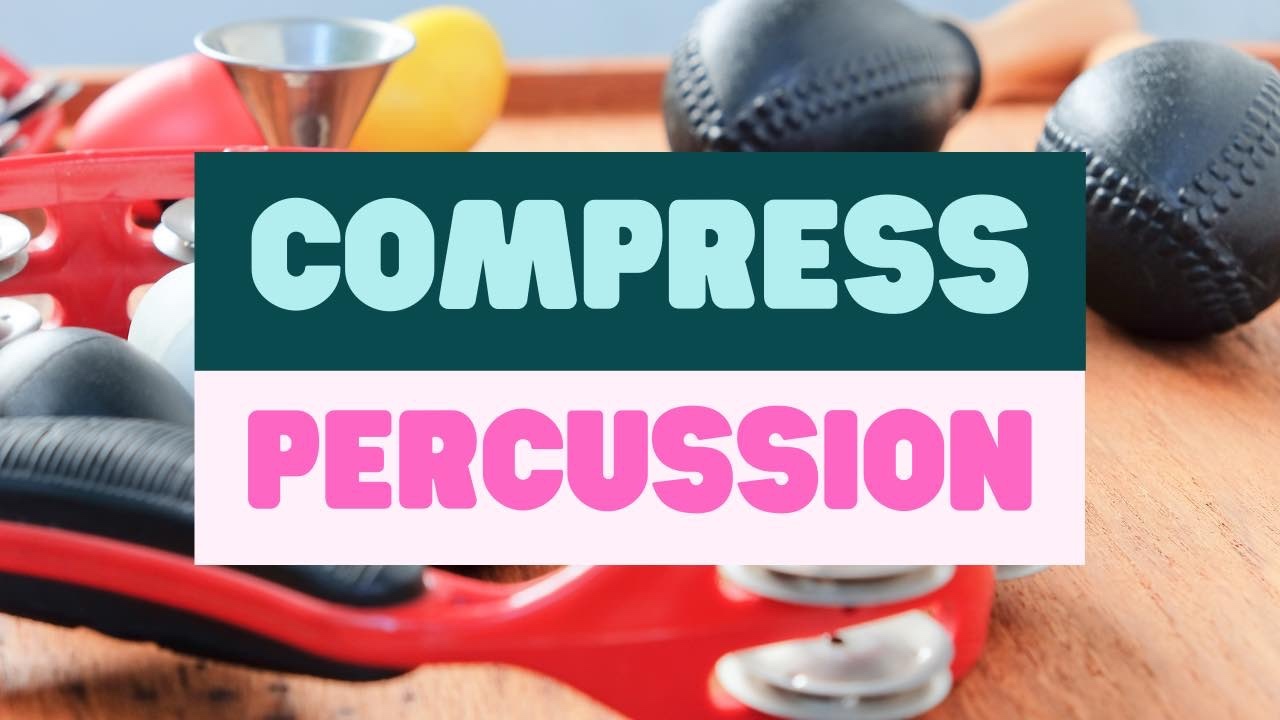How to Compress Percussion

There are a lot of different percussion instruments out there, and most of them benefit from some compression! In this guide you'll learn some of the most popular compressor settings for common percussion instruments, as well as tips for applying "glue" compression to your compressor bus.
Note: This article may contain affiliate links, meaning I would receive a commission - at no cost to you - for any products you purchase.
Challenges of Compressing Percussion
To me, percussion is a broad term for any rhythmic instrument that acts as a peripheral to your typical drum set.
Percussion instruments include shakers, tambourines, cowbells, bongos, congas, djembes, and much more! The difficult of compressing these types of instruments is that they all have vastly different transient characteristics.
A set of bongos will sound much more like a snare drum, meaning it will require different settings than a shaker or tambourine. Here's a description of all the different drums and percussion of the world.
I usually compress percussion for two reasons:
- I want to add glue to my percussion bus to make everything feel like it’s playing together (this article will teach you how to use bus compression to create glue).
- The transients in certain percussion instruments are poking out too much and I want to tame them (you can also try using one of these great transient shaper VST plugins).
Cowbell Compressor Settings
The cowbell is an instrument with a heavy attack and a quick sustain and release. When it comes to cowbell compression, you’ll need settings that can catch the transient to keep it from poking out of the mix.
I often like to start with a ratio between 3:1 and 6:1, and a slightly fast attack, anywhere from 10-20ms. The release can also be fairly fast, especially if you want to maintain the tail of the cowbell. An 1176-style compressor is great for this type of fast control.
The key is making sure your attack isn’t so fast that it diminishes the transient of your cowbell in any way, as this could take away from its rhythmic properties.
Conga & Bongo Compressor Settings
I often think of congas and bongos like snares when treating them in a mix. With fast transients and uniquely tonal sustains, there’s a lot of character that’s easy to destroy with the wrong compression settings.
I’ll typically start with a 3:1 to 4:1 ratio and dial in around 5-6dB of gain reduction to keep these instruments in place. The attack setting is by far the most important here, as you can use it adjust the amount of snap your hand drums have.
A slower attack will give you more snap, while a faster attack will give you less.
Tambourine Compressor Settings
A tambourine that is too dynamic can be incredibly annoying to listen to, which is often why I use compression to limit the dynamics between the louder and softer parts of the rhythm. The snap of a tambourine on an accentuated beat often needs control to sit back in the mix, especially when doubling the snare. I usually like to approach this part of a tambourine’s sound like a snare, due to its snappy qualities.
You can often use a medium to fast compression and a fast release with a ratio between 3:1 and 4:1, dialing in around 3-5dB of gain reduction
Learn more about Mixing with Compression
This is only one part of mixing with compression! Luckily, I've put together a bunch more articles to help you master this crucial mixing skill!
- How to Use a Compressor: Learn to Mix with Compression Quickly!
- Sidechain Compression Explained for Beginners & Key Settings
- 3 Tips for Using a Sidechain Compressor to Add Punch & Clarity
- Multi-band Compression Tutorial for Great Vocals, Drums & More!
- How to Use Mid-Side Compression for Amazing Recordings!
- How to Use Parallel Compression for Powerfully Punchy Mixes
- Should You Compress Reverb? The Real Answer Finally Revealed.
- The 5 Types of Compressors (And Exactly When To Use Each)
- 10 Vocal Compression Mixing Tips (Including Best Settings)
- 9 Powerful Drum Compression Techniques for Punchy Pro Mixes
- Loud, Punchy Kick Drums with these Compression Settings
- How to Compress Snare - Use *These* Settings Punchy Snares
- Exactly How to Compress Bass for Tight Low End Thump!
- How Compress Acoustic Guitar Perfectly, Every time
- How to Compress Synthesizers: Best Compressor Settings for Synths
- How to Compress Organ: 4 Steps to a Great Mix!
- How to Compress Percussion: Compression Settings for Everything
- How to Compress Strings: 8 Magic Settings You Need to Know
From a Frustrated Producer in a Ragtag Bedroom Studio to Major Placements on TV Earning $1,000s!
My name is Evan, and I've been making music since around 3rd grade. I'm from San Diego, California, but I've lived in Washington, DC for the last 20 years.
While I still have a full-time day job, I have created systems that have allowed me to produce dozens of songs a year in my spare time.
My songs have been on Netflix, TV shows like the 90 Day Fiance, an award-winning indie film, and NPR’s “All Thing Considered.” They've also been streamed millions of times.
In addition to being a music producer, I am passionate about teaching people how they can make professional-sounding music and earn money licensing it, all in their spare time.
Thousands of musicians, like yourself, have trusted me to guide their musical journey. My YouTube videos have been watched nearly a million times. And my story has been in Forbes, Side Hustle Nation, and the Side Hustle School.





